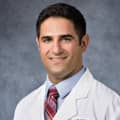Physicians and other medical professionals are usually able to make the diagnosis of an anterior cruciate ligament (ACL) tear by the patient’s history and physical exam.
In This Article:
Patient Interview
A person should be prepared to answer questions about his or her medical history and lifestyle. Additionally, a person should be prepared to answer questions, such as:
- When did the injury occur?
- How did the injury occur?
- Was the trauma accompanied by a “popping” sound or tearing sensation?
- Has the knee been injured before?
- Where is the location of the pain?
- If swelling is present, when did it start?
- Can you bear weight on your leg? If so, does it feel unstable?
In addition to these questions, the doctor will perform a physical exam to confirm the diagnosis of an ACL tear.
Physical Exam
A doctor will examine the patient’s knee, noting any swelling, tenderness, pain points, and range of motion. He or she may also perform certain physical tests, moving the affected knee (passive motion) or asking the patient to move the affected knee, with or without bearing weight on it.
Physical examination tests specifically designed to test the integrity of the ACL are particularly helpful when they are also performed on the other (healthy) knee for comparison. The most common exam is the Lachman's sign test.
Lachman’s sign test
This test is performed with the person on his or her back and the affected leg relaxed.
- The examiner holds the leg with one hand supporting the lower thigh and one hand supporting the upper calf.
- The physician gently bends the knee to about 30 degrees and then pulls the calf in a forward, upward motion.
The test may be performed on the unaffected knee as well. If the affected knee shows an increased range of motion compared to the other knee, the ACL is probably ruptured.
Other tests may also be performed to further assess the ACL as well as nearby structures, such as the meniscus and the medial collateral ligament (MCL).
Doctors typically suggest waiting until after any significant swelling has gone down to perform these tests because swelling can affect the accuracy of the exam.
Medical Imaging
Although many ACL tears can be diagnosed without medical imaging,1Brady MP, Weiss W. Clinical Diagnostic Tests Versus MRI Diagnosis of ACL Tears. J Sport Rehabil. 2018 Nov 1;27(6):596-600. doi: 10.1123/jsr.2016-0188. Epub 2018 Jul 27. Review. PubMed PMID: 29140170. a doctor may order one or more diagnostic medical imaging tests to confirm the presence and determine the severity of an ACL injury.
- X-rays gives doctors a view of a person’s bones. A plain x-ray of the knee is imperative if an ACL tear is suspected because of the risk of fracture.
- Magnetic resonance imaging (MRI) provides a detailed view of the ligaments, tendons, bones, and cartilage of the knee joint, including the ACL. An MRI of the knee is utilized to confirm the diagnosis, evaluate for other injuries to the knee, and help plan for surgery.
- Ultrasound imaging uses high-frequency sound waves to build a picture of the knee. Ultrasound shows resolution of the tendons and ligaments outside of the knee joint, but because of the ACL’s location deep inside the joint, ACL tears cannot be visualized with ultrasound.
See Soft Tissue of the Knee Joint
Once an accurate diagnosis has been made, the doctor and patient can move forward with treatment options.
- 1 Brady MP, Weiss W. Clinical Diagnostic Tests Versus MRI Diagnosis of ACL Tears. J Sport Rehabil. 2018 Nov 1;27(6):596-600. doi: 10.1123/jsr.2016-0188. Epub 2018 Jul 27. Review. PubMed PMID: 29140170.


